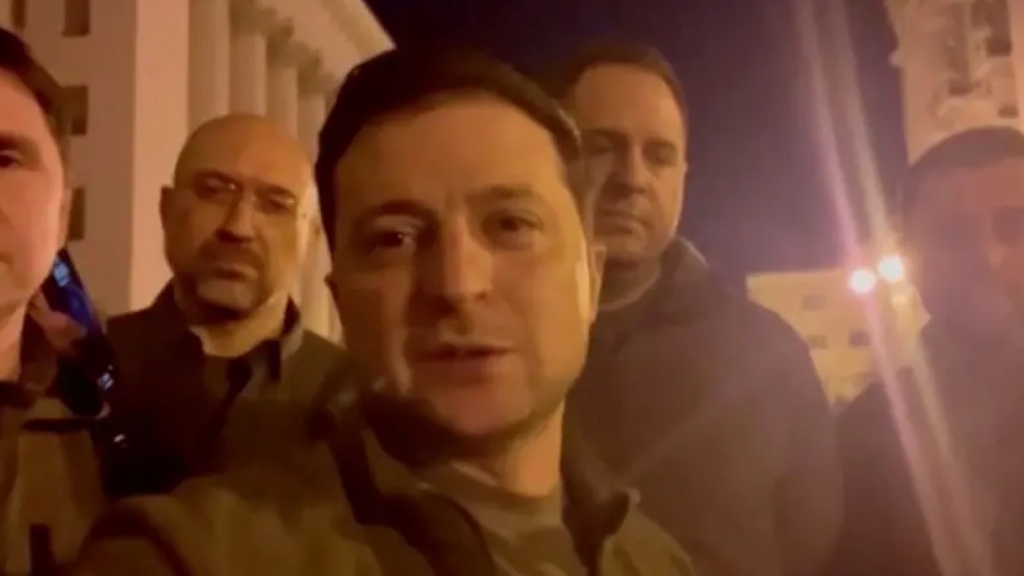
Running notebook on war, narrative, on the ground social media capture, and why the invasion of Ukraine and the heroic resistance of its president and people are getting etched deep into the collective memory.
Background: Why the Gulf War (1990–91) was forgotten per Chuck Klosterman (The Nineties [2022], 56):
The Gulf War was a triumph of public relations. But it was forgotten almost instantly. We tend to assume that seeing an event ‘live’ deepens its imprint on the mind. It should, in theory, make the experience more intense, and the associated emotions should be more ingrained. But the prolonged liveness of the Gulf War produced the opposite effect. Like a CGI action movie with no character development, the plot vaporized as it combusted. The network footage was live and raw, but dependent on the military’s willingness to grant those networks access, which meant the rawness was clandestinely cooked. The public saw almost no casualties from either side. The strategic success was robotic. Despite the buildings that were annihilated and the civilian lives that were lost, there was no obvious emotional component to the war, which meant there was no narrative. And since American audiences had been trained to understand the world through the process of storytelling, a war with no story was a war they did not care to remember.
Daniel Johnson (Slate, February 24):
It’s been less than 24 hours since Russia invaded Ukraine, yet we already have more information about what’s going on there than we would have in a week during the Iraq war. Already, Google Maps has revealed Russian armored invasion routes due to civilians in the area getting caught in traffic, leading Google to send out alerts. We know almost exactly when Russian forces began their helicopter air assault near Kyiv. We know that one of two Russian soldiers captured by Ukrainian forces on Thursday is probably 20 years old — a reporter found his social media account.
If you’re interested, you can find footage of airstrikes, ground battles, Russian helicopters getting shot down, civilians being targeted. Most of it isn’t coming from traditional sources. … What is coming out of Ukraine is simply impossible to produce on such a scale without citizens and soldiers throughout the country having easy access to cellphones, the internet, and, by extension, social media apps. A large-scale modern war will be livestreamed, minute by minute, battle by battle, death by death, to the world.
Thomas Friedman (NYT, February 25):
Our world is not going to be the same again because this war has no historical parallel. It is a raw, 18th-century-style land grab by a superpower — but in a 21st-century globalized world. This is the first war that will be covered on TikTok by super-empowered individuals armed only with smartphones, so acts of brutality will be documented and broadcast worldwide without any editors or filters. … Welcome to World War Wired — the first war in a totally interconnected world.
Roger Cohen (NYT, March 1):
TikTok, the video-sharing app with more than a billion active users, has shaped views of the conflict and contributed to an intense wave of global sympathy for Ukraine. Call it Resistance 4.0, the influencers’ war against an unprovoked Russian invasion.
Sheila Dang and Elizabeth Culliford (Reuters, March 1):
When Russia invaded Ukraine last week, some of social media’s youngest users experienced the conflict from the front lines on TikTok. Videos of people huddling and crying in windowless bomb shelters, explosions blasting through urban settings and missiles streaking across Ukrainian cities took over the app from its usual offerings of fashion, fitness and dance videos. … Montages of residential buildings destroyed by missiles, empty grocery store shelves and long lines of cars piled up outside gas stations could be seen on the TikTok pages of top Ukrainian influencers. … The app has become so influential in this conflict that Ukrainian President Volodymyr Zelenskiy appealed to “TikTokers” as a group that could help end the war, in a speech directed at Russian citizens. Some TikTokers picked up where the politician left off.
Drew Harwell and Rachel Lerman (Washington Post, March 1):
Early Monday, minutes after cluster bombs plunged into a neighborhood in Ukraine’s second-biggest city, Kharkiv, people nearby used social media to document the grisly aftermath. Ukraine’s underdog defense is nevertheless staring down a stark reality: that a fierce onslaught of troops and tanks, regrouping after early losses, continues to charge toward the capital. The glory of the scrappy resistance, less than a week into the invasion, could turn at any moment, and no amount of online victory will change that fact. But the information they’ve surfaced could help define how the world remembers the conflict.
Mike Allen (Axios PM email, after Zelensky addressed Congress via video from Kyiv [March 16, 2022]):
Zelensky’s speech evoked imagery of a youthful JFK, in his day the master of the new medium of TV, Axios politics editor Glen Johnson tells me. Zelensky is 44, using cellphone cameras and Zoom.